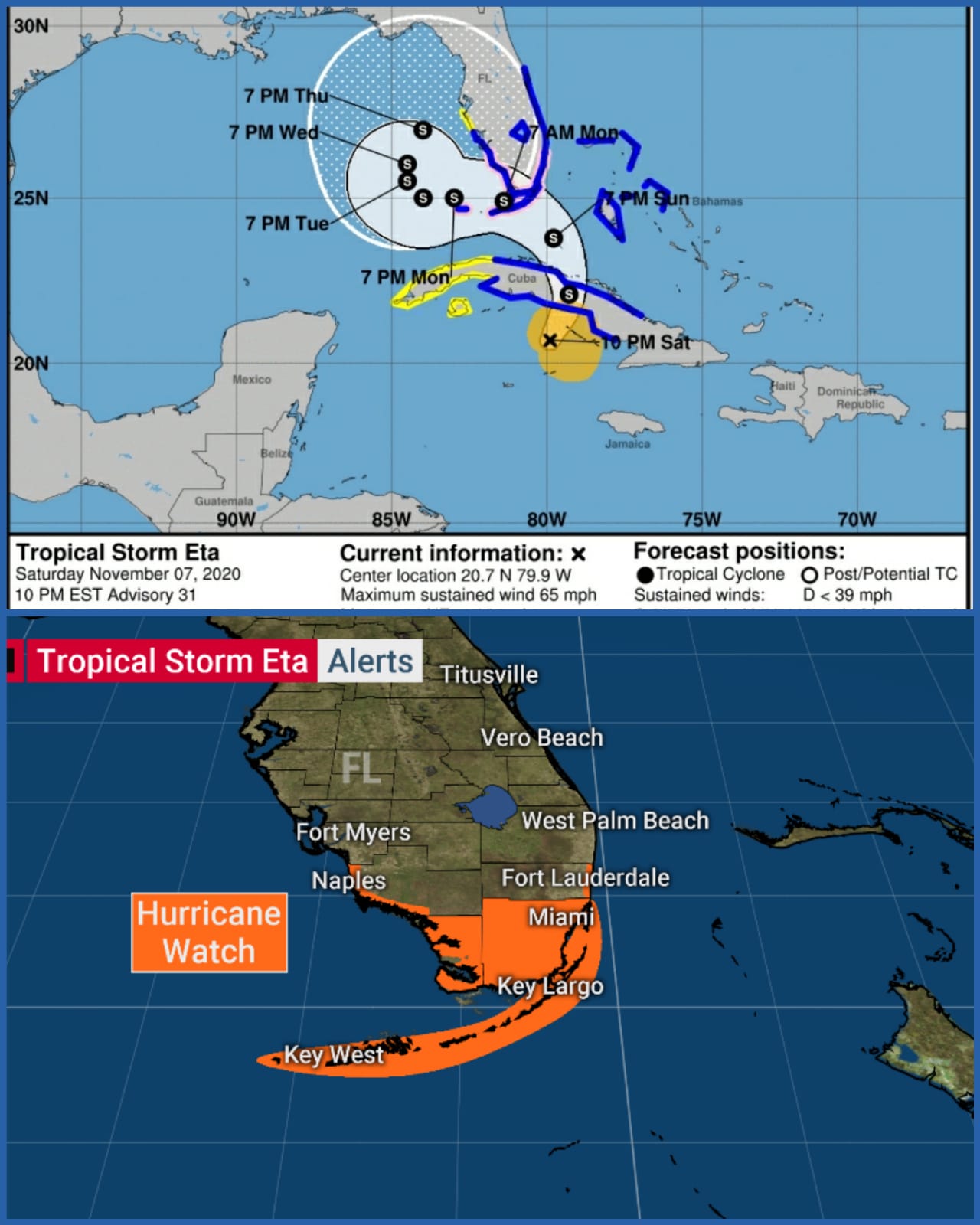TODAY IS THE DAY FOR MAXIMUM IMPACTS FROM TROPICAL STORM ETA IN SOUTH FLORIDA
The center of Tropical Storm Eta is just moving off the north coast of Cuba and into the Straits of Florida. But the bands of heavy rain and gusty winds already extend well north of the center, and will increasingly rotate over South Florida and north to the Treasure Coast and Central Florida through the day. Maximum impacts come later today and tonight.
Eta was slightly wounded in its transit over Cuba, but it should reorganize quickly. Although in this case, reorganization does not mean a storm with a defined eye and strong winds in an eyewall near the center of circulation. The maximum winds somewhere in the circulation are forecast to increase slightly as the center moves closer to South Florida through the day. Most of the strong winds will be in bands, and may be well away from the center.
It’s not out of the question that the peak winds in some of the bands could reach 75 mph – hurricane strength – but for the most part they are expected to stay below that threshold. Because of that possibility, however, a Hurricane Watch, meaning that hurricane-force winds are possible, is in effect for Broward, Miami-Dade, and the Keys.
This is NOT a situation where we should concentrate on the forecast cone and where the center of the storm is predicted to track. The overall gustiness of the winds will be higher within about 100 miles of the center, but the energy in this storm is very spread out.
A sharp dip in the jet stream interacting with Eta has created a comma-shaped storm with the strong winds and heavy rain north and east of the center. Even as the storm arcs to the left, with the center passing over or near the Keys tonight and tomorrow, the bands of weather with strong winds will extend north as far as Central Florida and east over the Bahamas.
On the Miami-Dade and Broward County coasts, bands of heavy rain with increasingly strong wind will migrate slowly from south to north. Late this afternoon into the overnight, some wind gusts are predicted to exceed 60 mph, with a few perhaps near 75 mph.
Rain in some of the bands will be extremely heavy, so flooding is a significant threat – especially considering the ground is saturated from the previous heavy rain this year. The National Weather Service is now predicting a widespread 6 to 12 inches of rain with some spots getting up to 18 inches. Heavy rain is predicted to cover the entire southern Florida peninsula as far north as Central Florida over the next couple of days.
Because the wind will so persistently blow onshore, the ocean and bay water along the coast in South Florida, the Keys, and Southwest Florida, may rise as high as 2 to 4 feet above normal high tide. High tides will come the early afternoon and very early morning hours, so since the wind should be highest later today, the concern will be during the early overnight for flooding of low-lying areas along the coast and the inland waterways.
If your neighborhood flooded during the King Tides, be sure to park your car on high ground tonight, be aware of water levels late this evening and in the hours around and after midnight, and pay attention to any instructions from your local officials about the possibility of flooding and what action you should take.
We have the possibility of isolated tornadoes in some of these bands, but as a general rule, you protect yourself from these tornadoes like you do from the strong winds. Stay away from the windows when the winds are really blowing outside. The winds in the tornadoes are not much higher than in the strongest gusts.
In the Keys, monitor the exact track of the center of the storm. This has less to do with the strength of the winds than the direction the wind is coming from. If the storm tracks down the Keys, as now seems possible, the wind ahead of the center will come off of Florida Bay, which will push water in from the north. The wind behind the storm will push water off the Atlantic.
It appears right now that the Middle and Lower Keys will be most affected by a possible 2 to 4-foot water rise from Florida Bay, if it occurs.
All of the Keys are subject to bands of high wind from late today through daytime tomorrow, at least.
On the southeast coast, winds will start to decrease tomorrow, but it will be a noticeably breezy day, especially in any leftover rain bands. We should see more breaks in the rain, however, since dry air is forecast to wrap into the storm creating slots without rain.
Eta is forecast to slowly move into the Gulf tomorrow and Tuesday. Its future path is unclear, as is its future strength. The computer forecast models present a range of possibilities. There is a reasonable chance, however, that it stays in the Gulf for a while pulling bands of tropical moisture over the Florida peninsula that contain gusty downpours.
The threat will be for more rain on top of the rain we get this weekend, so we’ll have to stay aware.
Before the winds pick up today, be sure your phones, computer, tablets, etc. are fully charged, along with any back-up batteries if you have them. Bring in anything that can blow around in your yard or on balconies. And tonight, keep flashlights with fresh batteries handy.
Be very conscious of where you park your car today. Avoid trees and low-lying areas, even if you have to walk a ways to find a safe place, you’ll be happy you did if branches come down or the street floods. Parking garages are a good alternative if there is one nearby.
Use good sense through this. It’s going to be nasty. Don’t drive if you don’t have to. Flooding can develop very quickly in heavy-rain scenarios like this.
Below are the forecast details from the National Hurricane Center.




